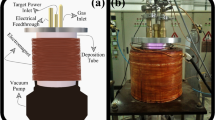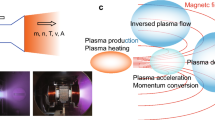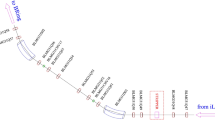Abstract
The possibility of using a plasma electron source (PES) with a discharge in crossed E × H field for compensating the ion beam from an end-Hall ion source (EHIS) is analyzed. The PES used as a neutralizer is mounted in the immediate vicinity of the EHIS ion generation and acceleration region at 90° to the source axis. The behavior of the discharge and emission parameters of the EHIS is determined for operation with a filament neutralizer and a plasma electron source. It is found that the maximal discharge current from the ion source attains a value of 3.8 A for operation with a PES and 4 A for operation with a filament compensator. It is established that the maximal discharge current for the ion source strongly depends on the working gas flow rate for low flow rates (up to 10 ml/min) in the EHIS; for higher flow rates, the maximum discharge current in the EHIS depends only on the emissivity of the PES. Analysis of the emission parameters of EHISs with filament and plasma neutralizers shows that the ion beam current and the ion current density distribution profile are independent of the type of the electron source and the ion current density can be as high as 0.2 mA/cm2 at a distance of 25 cm from the EHIS anode. The balance of currents in the ion source-electron source system is considered on the basis of analysis of operation of EHISs with various sources of electrons. It is concluded that the neutralization current required for operation of an ion source in the discharge compensation mode must be equal to or larger than the discharge current of the ion source. The use of PES for compensating the ion beam from an end-Hall ion source proved to be effective in processes of ion-assisted deposition of thin films using reactive gases like O2 or N2. The application of the PES technique makes it possible to increase the lifetime of the ion-assisted deposition system by an order of magnitude (the lifetime with a Ti cathode is at least 60 h and is limited by the replacement life of the deposited cathode insertion).
Similar content being viewed by others
References
U. Helmerssona, M. Lattemanna, J. Bohlmarka, A. P. Ehiasarianb, and J. Tomas, Thin Solid Films 513, 1 (2006).
J. S. Cho, S. Han, K. H. Kim, Y. W. Beag, and S. K. Koh, Thin Solid Films 445, 332 (2003).
W. T. Pawlewicz, T. R. Culver, M. W. Chiello, J. H. Zachistal, S. R. Walters, and D. A. Allen, Proc. SPIE 2262, 1 (1994).
H. R. Kaufman, R. S. Robinson, and R. I. Seddon, J. Vac. Sci. Technol. A 5, 2081 (1987).
S. Reyntjens and R. A. Puers, J. Micromech. Microeng. 11, 287 (2001).
A. Shabalin, M. Kishinevsky, and C. Quinn, in Proceedings of the 44th International Annual Technical Conference, Philadelphia, 2001, pp. 23–28.
D. A. Golosov and I. V. Svadkovskii, in Proceedings of the International Scientific School D Conference “Thin Films and Nanostructures,” Moscow, 2004, pp. 148–151.
Author information
Authors and Affiliations
Corresponding author
Additional information
Original Russian Text © A.P. Dostanko, D.A. Golosov, 2009, published in Zhurnal Tekhnicheskoĭ Fiziki, 2009, Vol. 79, No. 10, pp. 59–64.
Rights and permissions
About this article
Cite this article
Dostanko, A.P., Golosov, D.A. Neutralization of an ion beam from the end-Hall ion source by a plasma electron source based on a discharge in crossed E × H fields. Tech. Phys. 54, 1461–1466 (2009). https://doi.org/10.1134/S1063784209100090
Received:
Published:
Issue Date:
DOI: https://doi.org/10.1134/S1063784209100090




